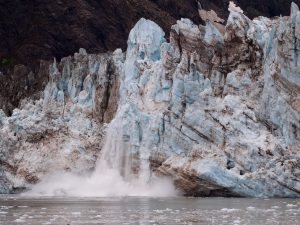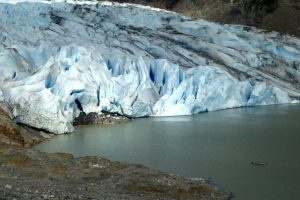
A mere 300 years ago, the Huna Tlingit people watched in horror as the behemoth advanced upon their village. Foot by foot it approached, eventually engulfing the entire village and their native lands. The entire livelihood of these native Alaskans was transformed not by the cataclysmic advance of some reconstituted prehistoric beast but something far more menacing: glacial ice. They saw the writing on the wall, all 1000’ of it, and it covered nearly all of what is now Glacier Bay. The tenacious Tlingit boarded their sea-worthy, hand-carved canoes and relocated 20 miles to the south to the village of Hoonah, not far from what is now Gustavus (gus-TAY-vus), Alaska. The year was 1750 and 40 years later, the British explorer and mariner George Vancouver visited the area, journaling about “a sheet of ice as far as the eye could distinguish” and about his crew’s ability to enter only 5 miles into the as yet unnamed bay.

Click to view our Glacier Bay Gallery.
Today, visitors travel over 90 miles into the bay to see glaciers, many of which were visited and studied by none other than John Muir on at least 3 expeditions well into the late 1800’s. In fact, he built a cabin near one glacier that bears his name. The area was declared a National Monument in 1925 by Calvin Coolidge, and its phenomenal beauty and grandeur teems with scientific importance. In the scant 200 years since the glacier receded, scientists have a pristine natural laboratory where they study the reappearance of life after centuries in a deep freeze. Beginning with lichens (the symbiosis of algae, fungus, and bacteria, all from different families), grasses, nitrogen-fixing legumes, alder, and eventually Sitka spruce trees reappeared. Soil scientists know that the steady accumulation of composted materials takes approximately 100 years to support trees, so the oldest spruces are also 100 years old. Our National Park interpretive ranger pointed out distant shore lines where the contour of the forest is a succession of varied heights beginning at sea level to the high tide mark, and eventually to the trees. The hills themselves are remnants of glacier movement, the massive weight of the ice forcing lateral buildup of soils not unlike us stepping in oozy mud. You know the feeling—mud squeezing between your toes and laterally outside your feet. Glaciers are like that, only slower, and coastal elevations are the result then the glacier recedes as it has over the past 200 years. Unlike coastal forests in Oregon & Washington’s northwest, there are virtually no “old growth” trees in Glacier Bay. No Sitka Spruce is older than 100 years old. That’s it. The unique opportunity to study in this wilderness was met with some opposition, as industry and commercial fishing was limited and eventually restricted. Science prevailed, arguing that limiting fishing deep in the bay has actually improved fishing in the icy straits nearby. And when science has the clout of a national park behind it, nature wins.
The natural wonders of the park don’t stop at the shoreline, however. The health of the park’s marine environment is equally protected in order to study the impact of returning ecosystems and their contribution to abundant marine life. As recently as 1980, there were virtually no sea otters so they were reintroduced and multiplied to nearly 8,000. Clearly the oyster and crab population is unable to sustain that population, but our ranger explained that there would be no intervention as their numbers would effectively level off in time. The same applies to the local black tailed deer population. We chuckled when our birding guide told us he’d seen one of the rare critters that very morning. We suggested a certain white tail variety in southern Oregon would flourish here and we’d happily contribute a few hundred.

in the shadow of calving glaciers.
While our restricted access to view calving glaciers entertained us, we learned that ice dropping into the bay creates a sound that both stuns fish (the birds love that) and frightens the Orca whales away from breeding seals (their favorite meal). For that reason, no boats are permitted before July 1 into the glacial drainages permitting seals to do their thing uninterrupted. After the 1st, limited access to small vessels is allowed by permit after that. Our day-long boat tour commissioned by the National Park took us to within a couple hundred yards of the John Hopkins Glacier where the captain shut down his engines and we floated with 2 other smaller vessels and several sea kayakers. The 60 or so visitors on our boat softened their voices respectfully as one would in an ancient cathedral. Periodically, a loud crack would break the silence, followed by tons of ice and debris cascading into the serene environment. The resulting waves were not a problem as kayakers kept a sensible distance from the towering wall that was misleading in size. It entirely filled the mile-wide valley, and 250 feet high at sea level.
After an hour or so, mesmerized in our glacial wonderland, we began the return that included passing an enormous cruise ship anchored well back from the glaciers. Their passengers experienced much of what we did albeit a mile farther away due to park restrictions. Because Glacier Bay is a science study area, our boats speed was restricted to 13 knots, approximately the speed of the numerous Humpback whales feeding there. In addition, we were treated to a couple male Orca whales swimming beside our vessel in search of yummy harbor seals and ignoring the playful sea otters—they’re simply not that tasty. Fur yes, but blubber, not so much.

watching Humpback Whales munch.
Another interesting thing about Glacier Bay is that Humpback whales find the diet perfect for fattening up for their 2,500 mile journey to Hawaii to mate. In preparation for that prodigious journey, these 50’ mammals consume 4,000+ pounds of of plankton, krill and small, and schooling fish each day, much of it outside the kelp beds of nearby islands barely 7 miles from Bartlett Cove where lies our National Park. Six of us hired a guide to take us kayaking near these feeding areas, and we were not disappointed as the whales repeatedly surfaced, loudly exhaling plumes of steamy air before submerging to eat. As we were in kayaks, it was important that we remain in shallow water otherwise the unsuspecting whales could easily capsize us. No bother as we equally enjoyed watching eagles diving for fish, oblivious to us nearby and returning to the shore to enjoy their meal. Our traveling buddy, Marty, opted to view the whales from a tour boat and got quite a show. While the humps rolled and occasionally waved their tails for us, Marty saw whales completely leap out of the water no fewer than 20 times, completely breaching the surface before crashing back into the calm water. While we missed Marty’s wonderful photo opportunity, kayaking within 50 yards of a surfacing whale was equally memorable.

Click to view our Juneau Photo Gallery.
After 3 blissful days in Gustavus, we returned to Juneau, the state capital, and camped in full view of Mendenhall glacier located just outside of town. Sooney and I hiked the 3 miles to lunch next to the glacier where visitors 50 years ago camped in its shadow. We also hiked up Mt. Roberts in downtown Juneau and returned in time to visit Alaska brewery for a taste of their fine American Pale Ale before being reunited with our traveling companions for cocktails and music.
Our final ferry ride was a 4-hour shuttle from Juneau to Haines, where our vehicles were unloaded for our 2-month road trip through “northern” Alaska. Stay tuned.
Bird & Critter Sightings for this leg of the trip:
Gustavus and Glacier Bay
Pacific Wrens, Chestnut-backed Chickadee, Barn Swallow, Pacific Crow, Common Raven, Stellar’s Jay, Pacific-slope Flycatcher, GB Heron, Spotted Sandpiper, Greater Yellowleg, Lesser Yellowleg, Least Sandpiper, Semipalmated Plover, Common Goldeneye with two ducklings, Barrows Goldeneye
Pigeon Guillemot, Surf Scoters, Glaucous-winged Gull, *Mew Gull, Herring Gull, Marbled Murrelet, Common Murre, *Black-legged Kittiwake, Pelagic Cormorant, Black Oystercatcher, Tufted Puffin, *Horned Puffin, *Kittlitz’s Murrelet, Bald Eagle
female cow moose (along Gustavus Rd.), Porcupine, two brown bears at shoreline in Glacier Bay, one black-tailed deer, sea otters, Humpback whales, Orca whales, Stellar sea lions, Harbor seals
Nagoonberry Trail, Gustavus
Barn Swallow, White-winged Crossbill, Chestnut-backed Chickadee, Golden-crowned Kinglet, Savannah Sparrow, Lincoln Sparrow, Song Sparrow, Dark-eyed Junco
Juneau/Mendenhall Glacier CG
Bald Eagle, *Mew Gull, Herring Gull, Glaucous-winged Gull, Bonaparte’s Gull, *Gray-cheeked Thrush, Varied Thrush, Hermit Thrush, American Robin, Common Merganser, American Dipper, Chestnut-backed Chickadee
* Life Birds (5 total to date)
